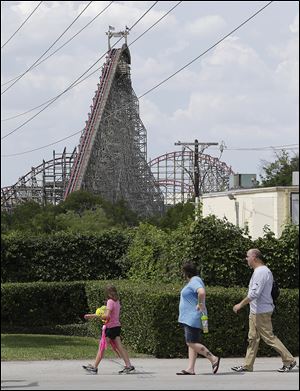
Theme parks tighten rules
More patrons barred from thrill rides because of girth
7/25/2013
The Texas Giant roller coaster ride sits idle as people walk outside the Six Flags Over Texas park Saturday in Arlington. Investigators will try to determine if a woman who fell to her death from the roller coaster was properly secured by ride operators.
The death of a roller coaster rider in Texas has focused attention on the vexing problem theme park operators face trying to accommodate passengers of various shapes in one-size-fits-all seats.
News reports about a woman who fell to her death from a Texas roller coaster suggest her girth may have played a role. The accident follows one in 2011 in which an Army veteran who had lost both legs fighting in Iraq plummeted to his death from a New York roller coaster.
Theme park ride designers and operators say the nation’s obesity problem and the improved mobility of people who are missing limbs have forced them to bar more patrons from thrill rides that are designed for passengers of certain proportions.
“Theme parks have been around 40-plus years, and sizing, in the past four decades, has changed a lot in America,” said Dennis Speigel, president of International Theme Park Services Inc., an Ohio industry consultant. “Some of these rides were designed back when people were a little smaller.”
At Six Flags Over Texas, Rosa Ayala-Goana, 52 — whose family called her Rosy Esparza — fell to her death Friday, reportedly after telling operators of the 14-story Texas Giant roller coaster that her safety bar didn’t seem to engage, according to witnesses, who described her as a large woman.
A spokesman for Six Flags Entertainment Corp. declined to comment, saying the accident remains under investigation.
At Six Flags Magic Mountain in Valencia, Calif., the fatal accident was a topic of conversation among park-goers. But few seemed anxious enough to stay off rides.
“I was a little worried, but it didn’t stop us,” Duke Spears, 45, of Phoenix said after riding roller coasters for a few hours with his daughter and girlfriend.
Still, the beefy coaster enthusiast said he takes precautions when he rides.
“I always tell them to make sure I’m locked in,” he said, pointing at his belly and laughing. “I do worry about it and always listen for that click.”
The latest thrill-ride accident is not likely to hurt turnout at theme parks this summer, experts said.
“In times like these, a paradox occurs,” said John Gerard, a longtime member of American Coaster Enthusiasts, a club of coaster fans. “More people want to ride it just because of the fact that it has that added aspect of danger.”
To help restrict extra-large riders, many parks have installed “sample seats” outside some of their roller coasters so passengers can see whether they fit before getting in line. Such seats have increasingly been added at theme parks across the country to gauge riders’ size.
Cedar Point in Sandusky has sample seats.
Also, Cedar Point's Web site, cedarpoint.com, alerts potential customers that “guests of larger size may not be accommodated on some of our rides.
“This may apply, but not be limited to, guests who exceed 6'2" or those who exceed 225 pounds, have a 40" waistline or 52" chest or females who exceed 200 pounds or wear a size 18 or larger.”
It then lists more than a dozen rides on which “larger guests may experience difficulty” and others where maximum recommended weight limits are posted.
The Texas Giant coaster at Six Flags Over Texas does not have a specific passenger weight limit, but the park’s safety and accessibility guide says the ride was designed to “accommodate people of average physical stature and body proportion.”
Large passengers are not the only riders facing restrictions.
Mr. Speigel said theme parks also are careful about allowing riders who are missing limbs because safety bars and harnesses are designed for people with two arms and two legs.
“That’s why parks are becoming more strict on who can and who can’t ride,” he said.
Two men who are missing limbs said in a lawsuit filed last year that at Universal Studios Hollywood, they were barred in 2011 from riding the indoor roller coaster Revenge of the Mummy: The Ride. The men, Angel Castelan and Marvin Huezo, said ride operators told them the park’s policy requires all riders to have at least one hand and one leg.
Universal Studios Hollywood declined to comment on the lawsuit. But a spokesman said the park’s “first priority is to take the necessary precautions to safeguard our guests while visiting our theme park. We carefully assess their individual needs to ensure their experience is safe and enjoyable at all times.”
In response to the Texas accident, the International Association of Amusement Parks and Attractions released statistics saying that the chances of being seriously injured on a theme park ride are 1 in 24 million and the chances of being killed on a ride are 1 in 750 million.
The trade group also said a majority of injuries take place because riders do not follow safety guidelines, which include height and weight restrictions.